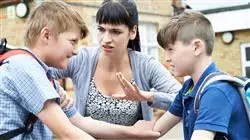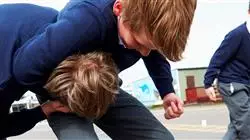University certificate
The world's largest faculty of education”
Introduction to the Program
Professional Classroom Mediation and Conflict Resolution skills are essential in any educational institution"

This program offers students an integral view of resolving classroom conflicts alongside successful models of approach, providing tools, experiences and advances that have been made in the sector and have been approved for this program by a specialized teaching faculty, all of them practising professionals. Each student will learn from the faculty's professional experience as well as evidence-based pedagogy, which will make their learning process even more effective and detailed.
Successful mediators possess skills that teachers can also develop and be of service to their institution as an intermediary between the students and the school; the educator’s intention would be to encourage and facilitate this process so that students can achieve their objectives. The role of the mediator in the education system is emerging as a skill that can improve the relationship between teachers and students, and result in a more harmonious atmosphere for everyone.
When introducing a new set of values to an educational system it is important that it be inclusive in nature, based on a biopsychosocial model that values diversity and is aimed at including the entire educational community as a whole.
Teachers from all stages of the educational process, as well as other professionals from, for example, the social health service, must become familiar with the characteristics of these students, be capable of identifying their needs, and should have the knowledge and necessary tools to intervene at a personal, socio-familial and, above all, educational level.
This Professional master’s degree is a pathway to achieving vital training and is directed mainly at kindergarten, primary, secondary and post-compulsory education teachers. This program provides the skills that will allow teachers to manage situations of conflict in the classroom as well as making them aware of the importance of diversity in the educational arena, creating diversity awareness plans and educational projects as well as mediation strategies which they can introduce in their schools.
A highly informative Professional master’s degree that will propel you to new levels of competitivity in the job market"
This Professional master’s degree in Classroom Mediation and Conflict Resolution contains the most complete and up-to-date educational program on the market. The most important features include:
- The latest online teaching software and technology
- Intensely visual teaching system, supported by graphic and schematic contents, easy to assimilate and understand
- Practical cases presented by practising experts
- State-of-the-art interactive video systems
- Teaching supported by telepractice
- Continuous updating and recycling systems
- Autonomous learning: full compatibility with other occupations
- Practical exercises for self-evaluation and learning verification
- Support groups and educational synergies: questions to the expert, debate and knowledge forums
- Communication with the teacher and individual reflection work
- Access to contents from any fixed or portable device with an internet connection
- Supplementary documentation databases are permanently available, even after the program
A contextualized and authentic learning experience that will allow you to put your learning into practice through the acquisition of new skills and competencies"
TECH's teaching staff includes professionals from the field of Classroom Mediation and Conflict Resolution, who bring their work experience to this training program, as well as renowned specialists belonging to leading societies and prestigious universities.
TECH's multimedia content, developed with the latest educational technology, will provide the professional with situational and contextual learning, i.e., a simulated environment that will provide immersive training for real situations.
This program is designed around Problem-Based Learning, whereby educators must try to solve the different professional practice situations that arise throughout the program. For this, the educator will be assisted by an innovative interactive video system developed by recognized experts in the field of Classroom Mediation and Conflict Resolution, who have extensive teaching experience.
Learn to make the classroom a place of development and growth by managing different contingencies skilfully and successfully"

A practical and realistic program that will provide you with the tools you require to help your students, their families and the staff at school move on from conflicts in a positive way"
Syllabus
The contents of this Professional master’s degree have been created based on two main objectives. Firstly, timeliness and efficacy, and secondly, the ability to aid students in a quick and efficient integration of the learning process This enables students to learn in a progressive and consistent manner, and advance to the highest level of competence in this field of work.

A highly educational program that will allow you to apply the new concepts and strategies from the very beginning, thanks to its practical and contextual approach"
Module 1. Introduction
1.1. Instructions for Awakening a Butterfly
1.1.1. Introduction
1.1.2. Bridging Gaps
1.1.3. Iconography of a Metamorphosis
1.1.4. Objectives for the Online Professional Master’s Degree
1.1.5. Contents of the Online Professional Master’s Degree
1.1.5.1. The Reception
1.1.5.2. Establishing the Bond is the First Step in Collaboration for Conflict Resolution
1.1.5.3. Data Collection is Essential for Conflict Analysis
1.1.5.4. Basic Needs Drive Conflicts
1.1.5.5. Power Struggles Are a Maze
1.1.5.6. Conflicts Have Their Phases, and These Must Be Understood
1.1.5.7. Dramatic Play: Role-Training in Conflict Resolution
1.1.5.8. Teacher Validating Style
1.1.5.9. Communication during Conflict
1.1.5.10. Express Reached Agreements
1.1.5.11. Breathe and Cleanse Prejudices
1.2. Chrysalis Moment
1.2.1. The Brain "Envelops" the Chrysalis
1.2.2. Two or Three Brains
1.2.3. The Amygdala is the Queen of Hearts
1.2.4. Conclusions for Moving within the Chrysalis
1.3. Ten Educational Truths Concerning Conflict
1.3.1. Ten Educational Truths
1.3.2. Two Styles for 10 Educational Truths
1.3.3. Invalidation Model - Damian's View
1.3.4. Validation Model - Damian's View
1.4. What is Conflict?
1.4.1. Introduction
1.4.2. Towards a Definition of Conflict
1.4.3. Conflict Characteristics
1.4.4. Types of Conflict
1.4.5. Most Frequent Causes of Conflict
1.4.6. What is Conflict Resolution?
1.5. Paradigm Shift
1.5.1. Introduction
1.5.2. What Elements are Involved in Conflicts?
1.5.2.1. Intrapersonal Side of Conflict
1.5.2.2. Interpersonal Side of Conflict: The Environment
1.5.2.3. Part of the Conflict Process
1.5.3. Conflict Analysis
1.6. Person’s Model Description for the 21st Century
1.6.1. Our Model Rationale
1.6.2. People and Relationships
1.6.3. Environment
1.6.4. Contact Zone
1.6.5. I Choose
1.6.6. Basic Needs
1.6.7. Organism/Body
1.6.8. Awareness
1.6.9. I Build
1.7. Description of Erikson's Psychosocial Processes of the Person
1.7.1. About the Author and His Theory
1.7.2. Erikson’s Developmental Stages
1.7.3. Why Choose Erikson's Model for Our Conflict Resolution Proposal?
1.7.4. First Stage - Infancy: Trust vs. Mistrust - First 18 Months of Life
1.7.5. Second Stage - Early Childhood: Autonomy Versus Shame and Doubt - 18 Months to 3 Years-Old
1.7.6. Third Stage - Age of Play: Initiative Versus Guilt - 3 to 5 Years-Old
1.7.7. Fourth Stage - Adolescence: Industriousness vs. Inferiority - 5 to 13 Years-Old
1.7.8. Fifth Stage - Youth: Identity Versus Role Confusion - 13 to 21 Years-Old
1.7.9. Sixth Stage - Maturity: Intimacy vs. Isolation -21 to 40 Years-Old
1.7.10. Seventh Stage - Adulthood: Generativity Versus Stagnation - 40 to 60 Years-Old
1.7.11. Eighth Stage - Old Age: Wholeness Versus Despair - Age 60 Until Death
1.7.12. Critique of Erikson
1.7.13. Phrases by Erikson
1.8. Bandura's Social Learning Theory
1.8.1. Introduction
1.8.2. The Role of Imitation
1.8.3. Two Videos for Drawing Conclusions
1.8.4. Why Talk About Bandura's Social Learning Theory?
1.9. Kohlberg’s Social Learning Theory
1.9.1. Introduction
1.9.2. Piaget's Stages of Moral Development
1.9.3. Kohlberg’s Stages of Moral Development
1.9.4. Cognitive Operations
1.10. Techniques to Manage Conflict at the First Stage
1.10.1. Introduction
1.10.2. Piaget's Stages of Moral Development
1.10.3. Kohlberg’s Stages of Moral Development
1.10.4. Cognitive Operations
Module 2. Bonding and Its Importance in Education
2.1. The Teaching Bond
2.1.1. Introduction
2.1.2. The Teacher Is Not in the Photo
2.1.3. Navigate within Ourselves
2.1.4. Confidence in Humor
2.1.5. In Conclusion
2.2. Bonding and Attachment
2.2.1. Introduction: Early Attachment Theory
2.2.2. Attachment Theory
2.2.2.1. Types of Attachment
2.2.2.2. Attachment Functions
2.2.2.3. Multiple Attachments
2.2.3. The Reference Figure in Bonding
2.2.4. In Conclusion
2.3. Strategies to Establish a Bond
2.3.1. Introduction
2.3.2. Observation
2.3.3. Empathy
2.3.4. Patience, Stability and Being
2.3.5. Humility
2.3.6. Believing in the Possibility
2.3.7. Authenticity and Consistency
2.3.8. Creativity
2.3.9. Joy and Humor Positivity
2.3.10. In Conclusion
2.4. The World of Children
2.4.1. Introduction
2.4.2. The Child’s Brain
2.4.3. The Moral Brain in Childhood
2.4.4. Characteristics of Childhood
2.4.4.1. Physical Changes
2.4.4.2. Cognitive Changes
2.4.4.3. Psychological Changes
2.4.4.4. Changes at the Social Level
2.4.5. Children Today
2.4.6. In Conclusion
2.5. Bonding in Childhood
2.5.1. Introduction
2.5.2. Feeling Appreciated and Noticed by Adults
2.5.3. Uncovering the Message of Disruptive Behavior
2.5.4. Boundaries Develop the Bond
2.5.5. Dogma vs. Affection
2.5.6. Here I Am, What Can We Do?
2.5.7. Being Interesting to a Child Opens the Door Becoming an Adult Reference
2.5.8. Being Fun to a Child Opens the Door
2.6. The Adolescent World
2.6.1. Introduction
2.6.2. The Adolescent Brain
2.6.3. Characteristics of Adolescence
2.6.3.1. On a Cerebral Level
2.6.3.2. On a Physical Level
2.6.3.3. On a Cognitive Level
2.6.3.4. On a Social and Emotional Level
2.6.3.5. On a Level of Identity
2.6.4. Myths during Adolescence
2.6.5. In Conclusion
2.7. Bonding in Adolescence
2.7.1. Introduction
2.7.2. The Peer Group
2.7.3. Group Pressure
2.7.4. Adolescent Self-Centeredness
2.7.5. Humor in Adolescent Bonding
2.7.6. Common Problems in Adolescence
2.8. Here and Now: Learning to Anchor
2.8.1. How to Develop Anchor Learning
2.9. Utopia and Utopianism: The Given and the Possible
2.9.1. Utopia
2.9.2. Utopianism
2.10. A Concept to be Recovered: Teacher Loyalty I'll Be Here Always
2.10.1. Teacher Loyalty
Module 3. Methods of Analysis of Events
3.1. Why Analyze Conflict?
3.1.1. Conflict in Education
3.1.2. Why Analyze Conflict?
3.1.3. A Journey through History
3.1.4. Positive Contributions of Conflict
3.2. Theoretical Approach
3.2.1. Based on Theory
3.2.2. Our Approach to Collecting Data
3.2.3. Differing Points of View
3.3. Contextual Approach
3.3.1. What is Context?
3.3.2. Relationships and Personality
3.3.3. Forms of Communication
3.4. How to Plan Analysis
3.4.1. Profile of the Mediator
3.4.2. The Need for a Plan
3.5. Planning Stages
3.6. Teaching Models
3.6.1. What is a Teaching Model?
3.6.2. Different Models for Conflict Mediation
3.7. Conflict to Children in Kindergarten
3.7.1. Active Listening
3.7.2. Below the Iceberg: What Did You Want Deep Down?
3.7.3. Reactions of Parties Involved
3.7.4. I Am Honest with my Emotions about What I Am Experiencing
3.7.5. I Fill in the Table
3.8. Conflict to Children in Primary Education
3.8.1. Active Listening
3.8.2. Below the Iceberg: What Did You Want Deep Down?
3.8.3. Person-Related Elements
3.8.4. Process-Related Elements
3.8.5. Communication-Related Elements
3.9. Conflict to Adolescents
3.9.1. Active Listening
3.9.2. Below the Iceberg: What Did You Want Deep Down?
3.9.3. Person-Related Elements
3.9.4. Process-Related Elements
3.9.5. Communication-Related Elements
3.10. Following Up
3.10.1. How to Follow Up
3.11. Teacher Support Resources
3.11.1. Different Teacher Support Resources
Module 4. Validate Emotions and Discover Basic Emotions
4.1. How Do People Establish Contact?
4.1.1. The Environment
4.1.2. Contact Zone
4.1.3. The Body
4.1.4. Basic Needs
4.1.5. I Choose
4.1.6. I Build
4.2. How to Acquire a Validating Style
4.2.1. Being Curious about the Details Given by Another Person
4.2.2. Being Curious about the Details Given by My Body
4.2.3. Extrinsic Emotional Attention: How Did That Make You Feel?
4.2.4. Intrinsic Emotional Attention: What Does What You Are Telling Me Sound Like?
4.3. How Do I Recognize My Basic Needs?
4.3.1. Identifying My Childhood Wound
4.3.2. How Can I Become Aware of My Fears?
4.3.3. How Can I Empathize with Someone Else’s Fears?
4.4. Honesty in My Response
4.4.1. The Shell: Responses that Prioritize Self-Protection
4.4.2. The Shell: Responses that Prioritize Adapting to Surroundings
4.4.3. The Anchor: Reality-Focused Responses
4.4.4. The Cloud: Possibility-Focused Responses
4.5. The World of Emotions
4.5.1. Emotions in the World
4.5.2. Galaxies and Constellations of Emotions
4.5.3. The Galaxy of Fear
4.5.4. The Galaxy of Rage
4.5.5. The Galaxy of Sadness
4.5.6. The Galaxy of Joy
4.5.7. The Galaxy of Surprise
4.5.8. The Galaxy of Affinity
4.5.9. The Galaxy of Disgust
4.6. Analysis Sheets for the Recognition of Basic Needs
4.6.1. Types of Worksheets
4.7. Online Resources on Basic Needs and Emotions
4.7.1. Online Resources on Needs
4.7.2. Online Resources on Basic Emotions
Module 5. Power Struggles Are a Maze
5.1. We All Manipulate
5.1.1. The Importance of Self-Esteem
5.1.2. Defending our Living Space
5.1.3. Emotional Manipulation
5.2. Roles in Power Struggles
5.2.1. The Oppressor
5.2.1.1. Aggression: The Manipulator's Weapon
5.2.1.2. Aggression Models
5.2.1.3. Moral Harassment
5.2.1.4. Governing through Aggression
5.2.2. The Victim
5.2.2.1. Crying as a Form of Manipulation
5.2.2.2. Governing through Victimhood
5.2.3. The Caregiver
5.2.3.1. Misunderstood Gratitude
5.2.3.2. Governing through the Caretaker
5.3. Power
5.3.1. The Need for Power Soils
5.3.2. Honest Search for Solutions
5.3.3. Searching for the Basic Need Underlying a Conflict
5.3.4. How to Ask Questions to Get out of a Power Struggle
5.4. Focus the Search on What I Can Do
5.4.1. Neither Power Struggle, Nor the Environment, Nor the Other Is to Blame
5.4.2. How to Discover What I Can Do
5.5. Manipulation at the Service of the Mediator
5.5.1. Manipulation, Just Another Technique
5.5.2. Role-Playing in the Power Struggle Game
5.5.3. Negotiation Techniques
5.6. Creating a New Identity
5.6.1. How to Save Aggressors from Themselves
5.6.2. How to Save Victims from Themselves
5.6.3. How to Save Caregivers from Themselves
Module 6. Conflict Phases
6.1. Disagreement
6.1.1. Beginning of the Conflict, Possible Causes
6.1.2. The Problem Concerns Both
6.1.3. Conflict Comes First
6.2. Personal Adversity
6.2.1. Blame and Reasons
6.2.2. People Come First
6.3. Mediation between Both Sides
6.3.1. Rights within a Dispute
6.3.2. Responsibilities within a Dispute
6.4. The Background, Just the Tip of the Iceberg
6.4.1. External Agents
6.4.2. Attitude toward External Agents
6.4.3. What is Really Happening Here?
6.5. What Can Each Party Do?
6.5.1. Proposed Solutions
6.5.2. Strengths, Threats, Weaknesses and Opportunities
6.6. New Developments in Each Party's View
6.6.1. Putting Oneself in the Other’s Shoes
6.6.2. Lateral Thinking
6.6.3. Thinking Patterns
6.7. Fitting in New Proposals
6.7.1. Feelings About Proposals
6.7.2. Strategies to Fit Them In
6.8. Ending the Conflict
6.8.1. What Does Ending a Conflict Involve?
6.8.2. Why Ending Conflicts is Important
6.9. Restoring Pain
6.9.1. How to Restore Pain
6.10. Erase Prejudices, Continue to Build
6.10.1. How to Erase Prejudices
Module 7. Dramatic Play: Role-Training in Conflict Resolution
7.1. What Is a Group?
7.1.1. What Is a Group?
7.1.2. Characteristics of a Group
7.1.3. Students Group Together How to Recognize Them
7.2. Group Dynamics
7.2.1. What Are the Techniques and Activities for?
7.2.2. What are the Core Competencies for Working with Drama?
7.2.3. Group Dynamics Techniques
7.3. Role Types in Conflicts
7.3.1. Classification: Mediating Chicks
7.3.2. Role Play Technique
7.4. How to Identify Roles in Students
7.4.1. Techniques to Identify the Different Roles
7.5. Shifting Roles: Context
7.5.1. The Johari Window at the Service of Roles
7.5.2. The Role Others Identify Me As What Others See and I Don't
7.5.3. The Role I’d Like to Have and How to Get It
7.6. The Teacher’s Role According to Their Participation
7.6.1. Activities in Which the Educator's Role Predominates
7.6.2. Activities Involving Educator and Students
7.6.3. Activities According to the Group’s Objectives
7.7. Dramatic Play: Role-Training in Conflict Resolution
7.7.1. How to Conduct Dramatic Play as Conflict Resolution Training
7.8. Drama: Integrating Core Competencies for Life
7.8.1. Play or Therapy?
7.8.2. Role-Playing Conflict in the Classroom
7.9. Sense of Humor in Role Management
7.9.1. Having a Sense of Humor in Role Management
7.10. Theater of the Oppressed as a Tool for Reflection in the Face of Conflict
7.10.1. Theater of the Oppressed
7.10.2. Using this Tool in the Face of Conflict
Module 8. Teachers' Educational Styles
8.1. Becoming Aware of My Educational Style
8.1.1. Starting by Knowing Oneself
8.1.2. Everyone Educates from their Own Backpack
8.1.3. On the Concept of Authority
8.1.4. Four Educational Styles/Approaches
8.2. Permissive Style
8.2.1. Characteristics of the Permissive Style
8.2.2. Adult Characteristics
8.2.3. Some Ideas If You Follow this Style
8.2.4. Consequences of This Style with Children
8.3. Overprotective Style
8.3.1. Characteristics of the Permissive Style
8.3.2. Adult Characteristics
8.3.3. Some Ideas If You Follow this Style
8.3.4. Consequences of this Style with Children
8.4. Authoritarian Style
8.4.1. Characteristics of the Permissive Style with Adults
8.4.2. Some Ideas If You Follow this Style
8.4.3. Consequences of this Style with Children
8.5. Cooperative Style
8.5.1. Characteristics of the Permissive Style
8.5.2. Adult Characteristics
8.5.3. Some Ideas If You Follow this Style
8.5.4. Consequences of this Style with Children
8.6. How to Speak so that Children Listen
8.6.1. Speaking Mechanisms so that Children Listen
8.7. How to Listen so that Children Speak
8.7.1. Speaking Mechanisms so that Children Speak
8.8. Active Listening Based on Validation from Others
8.8.1. Listening through Behavior
8.8.2. Naming Feelings
8.8.3. Discovering Basic Needs
8.8.4. Time to Listen
8.8.5. Establishing Eye Contact
8.9. Steps to Modify the Behavior of My Students
8.9.1. Defining the Problem
8.9.2. Approaching Problems One at a Time
8.9.3. Being Consequential and Consistent
8.9.4. Being Positive
8.9.5. Letting the Child Know What is Expected of Them
8.10. Basic Disciplinary Techniques
8.10.1. How to Give Praise
8.10.2. How to Ignore
8.10.3. How to Reward
8.10.4. How to Reprimand
8.10.5. Time-Out Technique
8.10.6. Problem Chairs
8.10.7. How to Use Overcorrection
Module 9. Communication in Conflict
9.1. Communication
9.1.1. Emitter
9.1.2. Receptor
9.1.3. Message
9.1.4. Communication Channels
9.2. Verbal, Non-Verbal and Paraverbal Communication
9.2.1. Verbal Communication
9.2.2. Non-Verbal Communication
9.2.3. Paraverbal Communication
9.3. Invalidating Communication
9.3.1. I Win/You Lose
9.3.2. You Win/I Lose
9.4. Validating Communication
9.4.1. I Win/You win
9.4.2. I Win and Help You Win
9.5. Choosing Assertive Communication During Conflict
9.5.1. Assertive Communication in Conflicts
9.6. How to Make Healthy Decisions
9.6.1. Healthy Decision-Making
9.7. There are Three Fingers Pointing At Me: Me Because You
9.7.1. Three Fingers Pointed at Me
9.8. Choosing Non-Violence: Non-Violent Communication. Four Versus One
9.8.1. Non-Violent Communication
9.9. Technology at the Service of Communication
9.9.1. Technology and Communication
9.10. Listening and Hearing
9.10.1. Listening
9.10.2. Hearing
Module 10. Ways of Expressing Reached Agreements
10.1. Reaching Agreement
10.1.1. Consensus
10.1.2. Commitment
10.1.3. Voting
10.1.4. Postponing the Decision
10.1.5. Customizable Solution
10.1.6. Arbitration
10.1.7. Lateral Thinking
10.1.8. Plus Minus Interesting (PMI)
10.1.9. Decision-Making Matrix
10.1.10. Negotiation
10.2. Remember Your Goal
10.2.1. The Goal and How to Remember It
10.3. Listen to What the Other Person Is Telling You
10.3.1. Learning to Listen to Others
10.4. Speak for Yourself, Not for Others
10.4.1. How to Speak for Oneself
10.5. Do not Start on Another Melon until you Finish the One you are Eating
10.5.1. How to Finish One Thing Before Starting Another
10.6. Put on Someone Else’s Glasses
10.6.1. How to Put Yourself in the Other's Place
10.7. Choose the Right Moment to Tell Them
10.7.1. How to Find the Right Moment to Start a Conversation
10.8. Don't Take It Personally
10.8.1. Don’t Take Matters into Private Domains
10.9. Uses the Sandwich Technique (Positive, Critical, Positive)
10.9.1. Definition of the Sandwich Technique
10.10. Express Yourself in Terms of: I Am Very Happy That You Have ... With Me
10.10.1. Knowledge of Positive Terms
Module 11. Breathing and Cleaning out Prejudices
11.1. Moving Deeper into Emotions
11.1.1. How to Manage Emotions
11.2. James Gross's Model of Emotion Formation
11.2.1. James Gross's Model
11.3. The Neuroscience of Emotions
11.3.1. Neuroscience
11.3.2. The Neuroscience of Emotions
11.4. Emotional Regulation
11.4.1. How to Regulate Emotions
11.5. Emotional Regulation Strategies
11.5.1. Different Strategies to Regulate Emotions
11.6. Assessment and Bias
11.6.1. Assessment
11.6.2. Prejudice
11.7. Techniques to Regulate Emotions: Mindfulness
11.7.1. Techniques to Regulate Emotions
11.7.2. Introduction to Mindfulness
11.8. What is Mindfulness?
11.8.1. Definition
11.8.2. Studying Mindfulness in Depth
11.9. Mindfulness Strategies to Regulate Emotions
11.9.1. Different Mindfulness Strategies
11.9.2. How to Regulate our Emotions through this Technique
11.10. How to Implement Mindfulness to Resolve Conflict
11.10.1. Using Mindfulness in Conflict Resolution

Study with us and compete among the most valued professionals in the sector"
Professional Master's Degree in Classroom Mediation and Conflict Resolution
The school environment agglomerates a vast set of factors (personal, structural, environmental, among others) that facilitate or hinder the daily coexistence among the educational community. The intervention of such factors makes teaching and pedagogical practice more complex, as specific tools are required to guarantee a serene learning space and to manage conflict situations. The Professional Master's Degree in Classroom Mediation and Conflict Resolution designed by TECH, aims to renew the knowledge of professionals in education, through the exposure of content related to the management of emotional flows and interrelationships present in educational processes. The contents of the program offer a complete vision of the phases of conflicts generated in the classroom, as well as the possible ways of resolution, through analysis and choice of different educational styles. From these, teachers will acquire the mediator's own skills, with which they will be able to cultivate in their students, a range of relational skills that, in turn, will allow them to build and rebuild a climate of understanding after each conflict.
Professional Master's Degree in Classroom Mediation and Conflict Resolution
To appease and solve the confrontations that occur in the classroom, it is essential to have skills that ensure the restoration of the parties involved and their respective re-integration into the school environment in a climate of peaceful coexistence. At TECH, this Professional Master's Degree has been created to guide teachers in the detection of behavioral and family difficulties in their students, as well as in the use of intervention mechanisms aimed at controlling intolerant or violent behavior and mitigating the impact of conflict in the classroom. With this master's degree, the teacher will simultaneously strengthen the ability to guide the emotional response of students involved in the conflict and to promote habits that avoid coexistence problems. All these tools will be equally useful in the creation and design of comprehensive mediation plans in schools.







